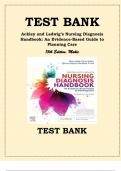Exam (elaborations)
Test Bank For Ackley and Ladwig’s Nursing Diagnosis Handbook: An Evidence-Based Guide to Planning Care 13th Edition (2024). Mary Beth Flynn Makic - All Chapters 1-30 PLUS Nursing Outcomes Classification (NOC), 6th edition Outcome Labels and Definitions
- Course
- Institution
- Book
Test Bank For Ackley and Ladwig’s Nursing Diagnosis Handbook: An Evidence-Based Guide to Planning Care 13th Edition (2024). Mary Beth Flynn Makic - All Chapters 1-30 PLUS Nursing Outcomes Classification (NOC), 6th edition Outcome Labels and Definitions (540 Outcomes) and Nursing Interventions Cl...
[Show more]



